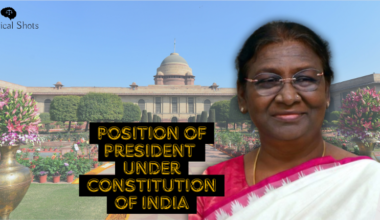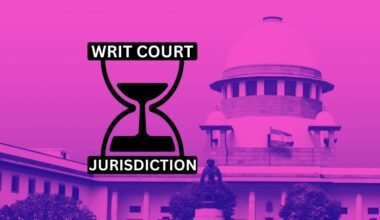For a layman to understand the functioning of democracy, one must comprehend the evolution of law that we abide by from a mere concept. A Bill begins as a rough draft, a simple idea in one’s mind, which, later through stringent procedures, takes the form of an Act, the law. These rigorous procedures include examination, heated debates and multiple approvals by people’s representatives, which gives the Bill the form of an Act. To safeguard the interests of society and its members, only the concepts that are most advantageous and well-thought-out are permitted to pass into law. This entire process demonstrates that creating laws isn’t about setting guidelines. It’s about keeping in focus the welfare of people. Let’s explore how a Bill becomes an Act – one step at a time.
What is a Bill?
Fundamentally, a bill is a draft of the legislative proposal that primarily outlines the governance of society. Consider it a template for a future law that needs to be thoroughly reviewed before it can be considered legally binding. Bills can be described as carefully drafted statutes that address various concerns of society. Concerns like financial issues, amendment of constitutional provisions or current laws, and establishing new statutes to adapt to an ever-evolving society.
The Indian Parliament categorizes different types of bills according to the concerns the bill addresses. An array of bills provided by the parliament includes Ordinary Bills, which address general issues, Money Bills that concentrate on the government’s finances, as well as Financial Bills and Constitutional Amendment Bills. The process of how Bill becomes Act may vary for each type of bill, but the core structure remains the same.
How a Bill becomes an Act: The Journey
The Parliamentary procedure begins when the concept is born in someone’s mind, way before a Bill arrives at the legislature, which lays the groundwork for responsible governance. At the initial stages, the appropriate Ministry/Member composes a draft of the proposed statute. There could be consultations with the other departments of the Ministry and, at times, opinions sought from the general public to guarantee a comprehensive approach.
Such a draft is meticulously modified to take into account the suggestions and obtain the necessary support before being subjected to approvals from the Cabinet. After receiving the necessary approvals from the Cabinet, the Bill is presented in the Parliament. The initial presentation of the Bill can be in either of the houses – Lok Sabha (House of the People) or Rajya Sabha (Council of States), thereby encouraging extensive and collaborative parliamentary discussion. But, it must be noted that the Money Bills are required to be exclusively presented in the Lok Sabha.
The Bill has to be approved in both the houses to become an Act of Parliament. The final assent required for how a Bill becomes an Act is that of the President of India. The President could call for a combined session to vote on the bill if the two houses cannot agree on it or if the second house has not received it for six months. Lastly, measures proposed or unresolved in the Lok Sabha expire and need to be reintroduced after the dissolution of the legislature.
First Reading: The Formal Introduction
The formal introduction of the Bill in the Indian Parliament is called the First Reading, where the introduction is delivered by the Member of Parliament or the Minister responsible for the Bill. This stage is referred to as the First Reading. The Minister in charge or the member then requests the House to grant its permission to introduce the Bill. It is a crucial moment when the Member of Parliament or the Minister outlines (reads aloud) the title, objectives and key provisions of the bill, and it can take place in either of the Houses. It’s crucial to remember that this is merely a ceremonial process that signifies the bill’s legislative debut, and there is no discussion or voting at that stage. The Bill becomes available to the public after its introduction in the Parliament, as it gets published in the Gazette of India. First Reading is an extremely significant step as it formally brings the House’s attention towards the Bill, thus marking the beginning of the formal journey of how a Bill becomes an Act.
Detailed Insights: Second Reading
During the Second Reading, the Bill requires significant attention from the Members of Parliament. It is a pivotal stage that involves comprehensive discussions and debates about the Bill details, such as provisions and, key features, so that multiple opinions can be deliberated upon. This ensures that all views can be voiced to provide clarity and conviction over the Bill, and may include advantageous suggestions through amendments. The second reading consists of multiple stages:
- General Discussion: Members discuss the fundamental concepts of the bill, exchanging differing opinions to help define its goals.
- Committee Stage (if referred): If the Bill is being referred to a Select or Joint Committee, it undergoes a thorough examination where expert opinions and public views are taken into consideration to make improvements.
- Consideration Stage: The members of parliament, after debating each clause of the Bill, propose amendments and vote on them. This comprehensive review ensures the legislation is thoroughly scrutinized and refined, ultimately better serving the community’s needs.
Final Approval: Third Reading
In the Final Approval stage, the entire House focuses solely on the approval or disapproval of the Bill through intense debates by the lawmakers. To maintain clarity in the Bill and make a responsible judgment, no modifications are permitted at this stage. If the House’s vast majority is in favour of the bill, then the bill gets passed down to the other house for consideration.
Consideration by the Second House
The Second House follows the same procedure while it deliberates on the approval of the Bill. It begins with the First Reading, followed by the Second Reading, which involves thorough analysis, and then moves on to the final stage of approval in the Third Reading. The Second House has the authority to either approve the Bill as it was proposed or suggest modifications, reject it, or delay any decisions on it. If any modifications are being recommended, then the Bill gets sent back to the First House for it to gain their approval.
Resolving Disagreements: Joint Sitting
The Two Houses may have conflicting opinions in terms of modifications of the Bill; there may be an outright rejection or may be at an impasse or deadlock. In such situations, the authority to call for a joint meeting is with the President. In such joint Sessions, the Speaker of the Lok Sabha presides over the meeting and in these significant sessions, a simple majority is required to pass the Bill. There are certain types of Bills, like Constitutional Amendment Bills and Money Bills, which are exceptions to such provisions.
Becoming the Law: Presidential Assent
After both Houses approve the Bill with the necessary majority or if it passes in a joint session, it must be sent to the President for their assent. In such a scenario, the President can choose to * Transform a Bill into an Act by giving their approval.
- Disapprove the Bill by rejecting the petition.
- Return the Bill for reconsideration (with the exception of Money Bills). But if the Legislature, even after reconsideration, passes the Bill and resends it for the President’s assent, the President is bound to approve it.
Gazette Notification: The Final Step
The final stop before the Bill is recognized as an Act is the Publication of the Act in the Gazette of India. The Act cannot be enforced legally or come into effect without such publication, which makes this stage a crucial one. Special Types of Bills Within this framework, we encounter special categories of bills:
- Constitutional Amendment Bills: These Bills may require formal support from state legislatures, while it is to be noted that they need a special majority in both Houses to be passed. Crucially, they are not subjected to the joint sitting procedure.
- Money Bills: The Rajya Sabha has limited authority, which is to provide recommendations to modify the Bill. Still, it cannot amend or reject them, whereas these financial Bills must originate from the Lok Sabha.
Conclusion
The procedure of moving a bill through the Indian Parliament is significant. It requires debate and thorough investigation to ensure that laws are well-designed. It also assures that a Bill is in the country’s best interests. It ensures that a Bill benefits the country. Bills are examined by MPs from both chambers of Parliament. It can only be accomplished by making the legislative process responsible and transparent.
The process of how a Bill becomes an Act has been explained by our intern, Ms Trinetra Thobde. She has been assisting the team in bringing informational legal blogs.








